Voet D., Voet Ju.G. Biochemistry
Подождите немного. Документ загружается.

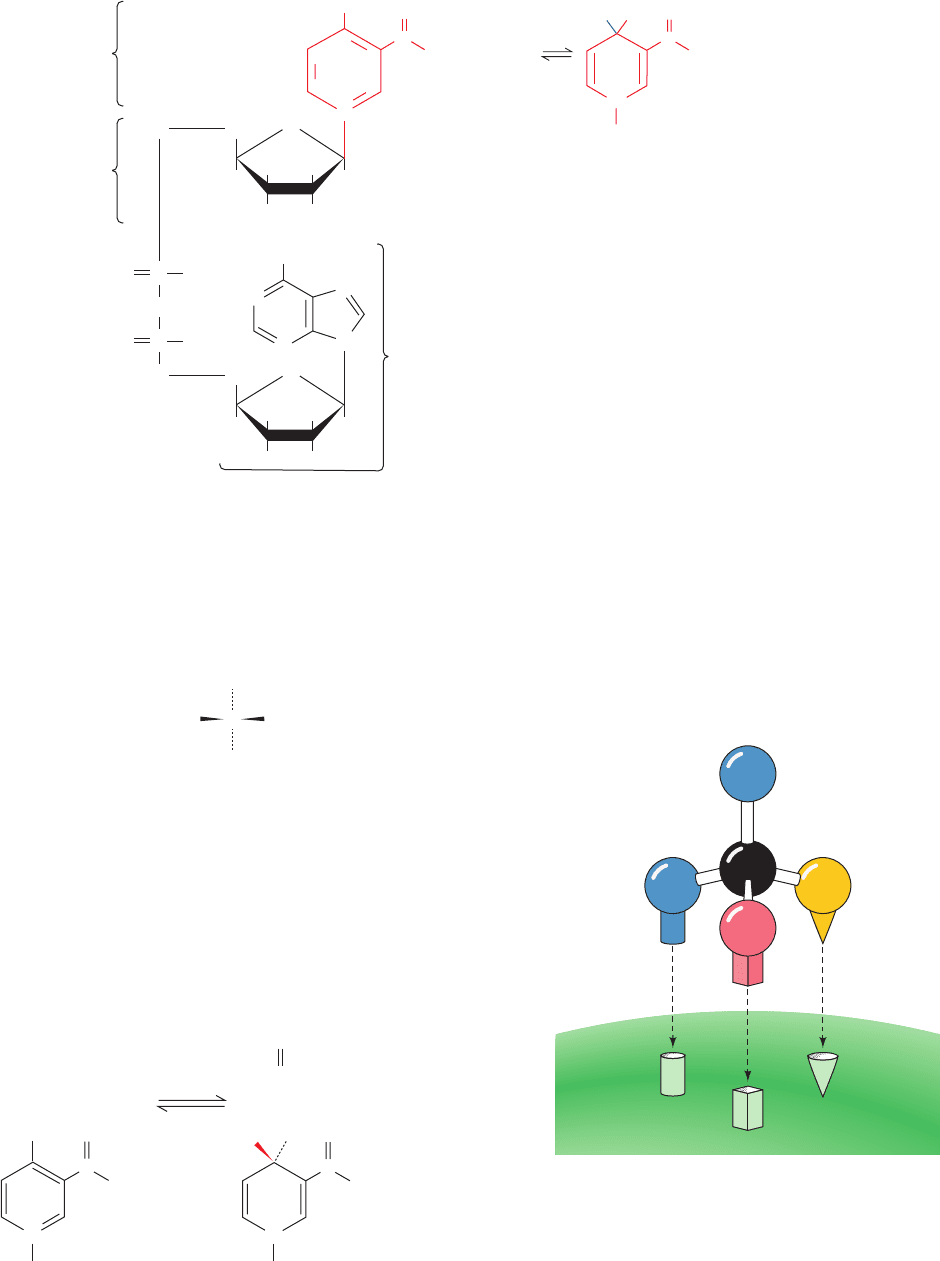
Section 13-2. Substrate Specificity 471
The structures of NAD
⫹
and NADH are presented in Fig.
13-2. Ethanol, it will be recalled, is a prochiral molecule
(see Section 4-2Ca for a discussion of prochirality):
Ethanol’s two methylene H atoms may be distinguished
if the molecule is held in some sort of asymmetric jig (Fig.
13-3). The substrate-binding sites of enzymes are, of course,
just such jigs because they immobilize the reacting groups of
the substrate on the enzyme surface.
Westheimer and Vennesland elucidated the stereospe-
cific nature of the YADH reaction through the following
series of experiments:
1. If the YADH reaction is carried out with deuterated
ethanol, the product NADH is deuterated:
N
H
R
NAD
+
NADD
C
O
NH
2
YADH
+
+
CH
3
CD
2
OH
N
HD
R
C
O
NH
2
O
+
+
CH
3
CD
H
+
OH
CH
pro-R
H
pro-S
CH
3
Note that the nicotinamide ring of NAD
⫹
is also prochiral.
2. On isolating this NADD and using it in the reverse
reaction to reduce normal acetaldehyde, the deuterium is
Figure 13-2 The structures and reaction of nicotinamide
adenine dinucleotide (NAD
ⴙ
) and nicotinamide adenine
dinucleotide phosphate (NADP
ⴙ
). Their reduced forms are
NADH and NADPH. These substances, which are collectively
referred to as the nicotinamide coenzymes or pyridine
nucleotides (nicotinamide is a pyridine derivative), function, as is
indicated in later chapters, as intracellular carriers of reducing
equivalents (electrons). Note that only the nicotinamide ring is
changed in the reaction. Reduction formally involves the transfer
of two hydrogen atoms (Hⴢ), although the actual reduction may
occur via a different mechanism.
Figure 13-3 Prochiral differentiation. The specific attachment
of a prochiral center to an enzyme binding site permits the
enzyme to differentiate between prochiral groups. Note: If it
were possible, the binding of the prochiral molecule’s mirror
image to the same three sites from the underside of the binding
site as pictured here would still result in H
pro-R
pointing toward a
different position.
Oxidized form Reduced form
H
H H
R
H
HH
OHHO
H
N
O
O
O
C
NH
2
NH
2
NH
2
2 [H
•
]
CH
2
H
HH
OXHO
H
O
O
O
O
O
–
O
–
O
CH
2
4
1
3
2
5
6
+
+
C
O
H
+
+
N
P
P
N
N
N
N
Adenosine
Nicotinamide
D-Ribose
X = H Nicotinamide adenine dinucleotide (NAD
+
)
X = PO
3
2
_
Nicotinamide adenine dinucleotide phosphate (NADP
+
)
OH
Enzyme
C
H
pro-R
H
pro-S
C
H
3
JWCL281_c13_467-481.qxd 2/18/10 11:26 AM Page 471
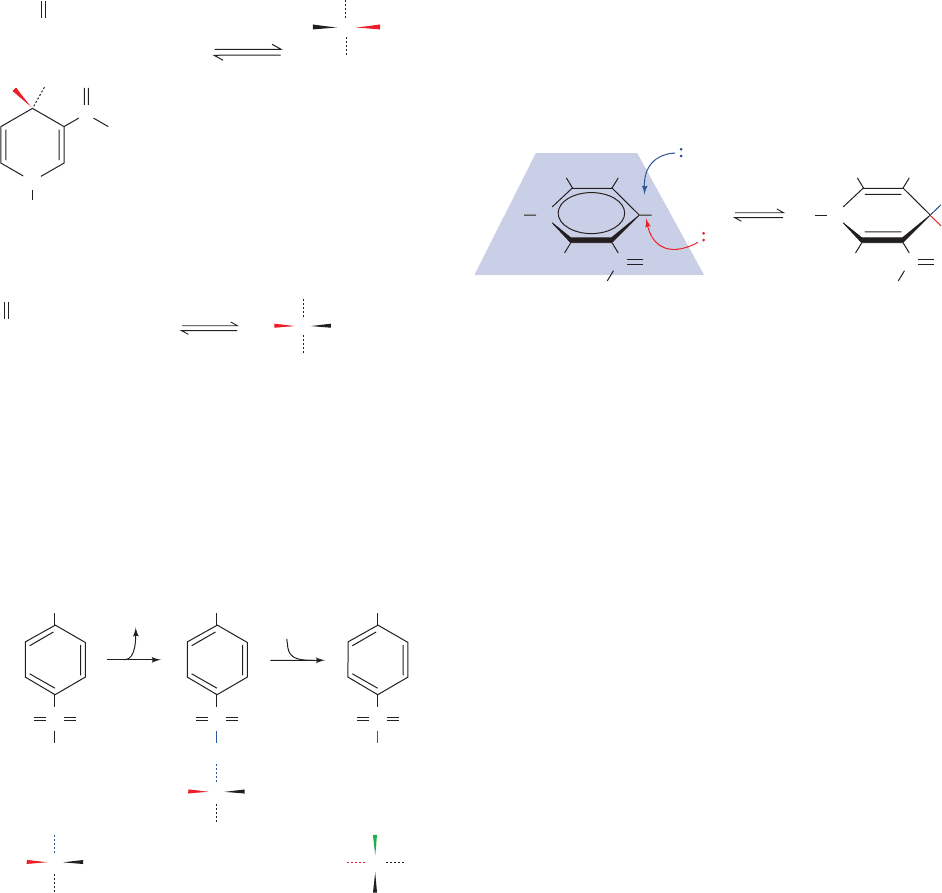
a. Stereospecificity in the NADH-Dependent
Dehydrogenases May Have Functional Significance
In our exploration of metabolism, we shall encounter
numerous species of NADH-dependent dehydrogenases
that function to reduce (or oxidize) a great variety of sub-
strates. These various dehydrogenases are more or less
equally distributed between those transferring the pro-R
(re-side) and the pro-S (si-side) hydrogens at C4 of NADH
(also known as A-side and B-side transfers).
Yet, despite the fact that si- and re-side hydrogen trans-
fers to or from the nicotinamide ring yield chemically iden-
tical products, a particular specificity of transfer is rigidly
maintained within classes of dehydrogenases catalyzing
similar reactions in different organisms. Indeed, dehydroge-
nases that catalyze reactions whose equilibrium constants
with their natural substrates in the direction of reduction
are ⬍10
⫺12
M almost always transfer the nicotinamide’s
pro-R hydrogen, whereas those with equilibrium constants
⬎10
⫺10
M generally transfer the pro-S hydrogen. Why has
evolution so assiduously maintained this stereospecificity?
Is it simply the result of a historical accident or does it serve
some physiological function?
The NADH hydrogen transferred in a given enzymatic
reaction is almost certainly that on the side of the nico-
tinamide ring facing the substrate. It was therefore widely
assumed that the stereospecificity in any given class of de-
hydrogenases simply arose through a random choice made
early in evolutionary history. Once made, this choice be-
came “locked in,” because flipping a nicotinamide ring
about its glycosidic bond in NADH would result, it was
presumed, in its carboxamide group obstructing catalyti-
cally essential residues on the enzyme.
In an effort to shed light on this matter, Steven Benner
mutated YADH in a manner that the X-ray structure of the
closely similar enzyme horse liver alcohol dehydrogenase
(LADH) suggests permits the si face of nicotinamide to
bind to the enzyme without interfering with catalysis. The
resulting mutant enzyme (Leu 182 S Ala) makes one
stereochemical “mistake” every 850,000 turnovers versus
one mistake every 7 billion turnovers for wild-type (unmu-
tated) YADH. This 8000-fold decrease in stereospecificity
indicates that at least some of the side chains responsible
for YADH’s stereospecificity are not essential for catalysis
and hence strengthens the argument that stereospecificity
in the dehydrogenases has functional significance.
B. Geometric Specificity
The stereospecificity of enzymes is not particularly surpris-
ing in light of the complementarity of an enzymatic binding
site for its substrate. A substrate of the wrong chirality will
472 Chapter 13. Introduction to Enzymes
re-side
addition
si-side
addition
HH
HRN
HCO
1
23
6
5
4
+
H
–
H
–
NH
2
HH
H
pro-R
H
pro-S
RN
HCO
1
23
6
5
4
NH
2
quantitatively transferred from the NADD to the acetalde-
hyde to form the product ethanol:
3. If the enantiomer of the foregoing CH
3
CHDOH is
made as follows:
none of the deuterium is transferred from the product
ethanol to NAD
⫹
in the reverse reaction.
4. If, however, this ethanol is converted to its tosylate
and then inverted by S
N
2 hydrolysis to yield the enan-
tiomeric ethanol,
the deuterium is again quantitatively transferred to NAD
⫹
in the YADH reaction.
The foregoing observations, in addition to showing that
there is direct hydrogen transfer in the YADH reaction
(Experiments 1 and 2), indicate that the enzyme distin-
guishes between the pro-S and pro-R hydrogens of ethanol
as well as the si and re faces of the nicotinamide ring of
NAD
⫹
(Experiments 2–4). It was later demonstrated, by
stereospecific syntheses, that YADH transfers the pro-R
hydrogen of ethanol to the re face of the nicotinamide ring
of NAD
⫹
as is drawn in the preceding diagrams.
The stereospecificity of YADH is by no means unusual.
As we consider biochemical reactions we shall find that
nearly all enzymes that participate in chiral reactions are ab-
solutely stereospecific.
p
-Toluenesulfonyl
chloride
(tosyl chloride)
OH
OH
_
CHD
CH
3
CH
3
CHD
CH
3
+
OOS
Cl
HCl
OH
OH
CHD
CH
3
CH
3
+
OOS
CH
3
OO
O
S
CH
3
CD
CH
3
OH
CDNADH NAD
+
++ +H
+
H
O
YADH
YADH
O
+
+
CH
3
CH
N
HD
R
C
O
NH
2
OH
D
H
CH
3
C
NAD
+
+
H
+
JWCL281_c13_467-481.qxd 2/18/10 11:26 AM Page 472

Section 13-3. Coenzymes 473
not fit into an enzymatic binding site for much the same rea-
sons that you cannot fit your right hand into your left glove.
In addition to their stereospecificity, however, most enzymes
are quite selective about the identities of the chemical groups
on their substrates. Indeed, such geometric specificity is a
more stringent requirement than is stereospecificity. After
all, your left glove will more or less fit left hands that have
somewhat different sizes and shapes than your own.
Enzymes vary considerably in their degree of geometric
specificity. A few enzymes are absolutely specific for only
one compound. Most enzymes, however, catalyze the reac-
tions of a small range of related compounds. For example,
YADH catalyzes the oxidation of small primary and sec-
ondary alcohols to their corresponding aldehydes or ke-
tones but none so efficiently as that of ethanol. Even
methanol and isopropanol, which differ from ethanol only
by the deletion or addition of a CH
2
group, are oxidized by
YADH at rates that are, respectively, 25-fold and 2.5-fold
slower than that for ethanol. Similarly, NADP
⫹
, which dif-
fers from NAD
⫹
only by the addition of a phosphoryl
group at the 2¿ position of its adenosine ribose group (Fig.
13-2), does not bind to YADH. On the other hand, there
are many enzymes that bind NADP
⫹
but not NAD
⫹
.
Some enzymes, particularly digestive enzymes,are so per-
missive in their ranges of acceptable substrates that their
geometric specificities are more accurately described as
preferences. Carboxypeptidase A, for example, catalyzes the
hydrolysis of C-terminal peptide bonds to all residues except
Arg, Lys, and Pro if the preceding residue is not Pro (Table
7-1).However,the rate of this enzymatic reaction varies with
the identities of the residues in the vicinity of the C-terminus
of the polypeptide (see Fig.7-5). Some enzymes are not even
very specific in the type of reaction they catalyze. Thus chy-
motrypsin, in addition to its ability to mediate peptide bond
hydrolysis, also catalyzes ester bond hydrolysis.
Moreover, the acyl group acceptor in the chymotrypsin
reaction need not be water; amino acids, alcohols, or am-
monia can also act in this capacity.You should realize, how-
ever, that such permissiveness is much more the exception
than the rule. Indeed, most intracellular enzymes function
in vivo (in the cell) to catalyze a particular reaction on a
specific substrate.
3 COENZYMES
Enzymes catalyze a wide variety of chemical reactions.
Their functional groups can facilely participate in acid–
base reactions, form certain types of transient covalent
RC +
O
NHR⬘ H
2
O RC +
O
O
–
H
3
NR⬘
+
chymotrypsin
Peptide
RC +
O
OR⬘ H
2
O RC +
O
O
–
HOR⬘
chymotrypsin
Ester
H
+
bonds, and take part in charge–charge interactions (Sec-
tion 15-1). They are, however, less suitable for catalyzing
oxidation–reduction reactions and many types of group-
transfer processes. Although enzymes catalyze such reac-
tions, they mainly do so in association with small molecule
cofactors, which essentially act as the enzymes’ “chemical
teeth.”
Cofactors may be metal ions, such as the Zn
2⫹
required
for the catalytic activity of carboxypeptidase A, or organic
molecules known as coenzymes, such as the NAD
⫹
in
YADH (Section 13-2A). Some cofactors, for instance
NAD
⫹
, are but transiently associated with a given enzyme
molecule, so that, in effect, they function as cosubstrates.
Other cofactors, known as prosthetic groups, are essen-
tially permanently associated with their protein, often by
covalent bonds. For example, the heme prosthetic group of
hemoglobin is tightly bound to its protein through exten-
sive hydrophobic and hydrogen bonding interactions to-
gether with a covalent bond between the heme Fe
2⫹
ion
and His F8 (Sections 10-1A and 10-2B).
Coenzymes are chemically changed by the enzymatic
reactions in which they participate. Thus, in order to com-
plete the catalytic cycle, the coenzyme must be returned to
its original state. For prosthetic groups, this can occur only
in a separate phase of the enzymatic reaction sequence. For
transiently bound coenzymes, such as NAD
⫹
, however, the
regeneration reaction may be catalyzed by a different en-
zyme.
A catalytically active enzyme–cofactor complex is
called a holoenzyme (Greek: holos, whole). The enzymati-
cally inactive protein resulting from the removal of a
holoenzyme’s cofactor is referred to as an apoenzyme
(Greek: apo, away); that is,
Table 13-1 lists the most common coenzymes together
with the types of reactions in which they participate.We shall
holoenzyme (active)
Apoenzyme (inactive) ⫹ cofactor Δ
Table 13-1 The Common Coenzymes
Coenzyme Reaction Mediated Section Discussed
Biotin Carboxylation 23-1A
Cobalamin (B
12
) Alkylation 25-2E
coenzymes
Coenzyme A Acyl transfer 21-2A
Flavin Oxidation– 16-2C
coenzymes reduction
Lipoic acid Acyl transfer 21-2A
Nicotinamide Oxidation– 13-2A
coenzymes reduction
Pyridoxal Amino group 26-1A
phosphate transfer
Tetrahydrofolate One-carbon group 26-4D
transfer
Thiamine Aldehyde transfer 17-3B
pyrophosphate
JWCL281_c13_467-481.qxd 2/18/10 11:26 AM Page 473
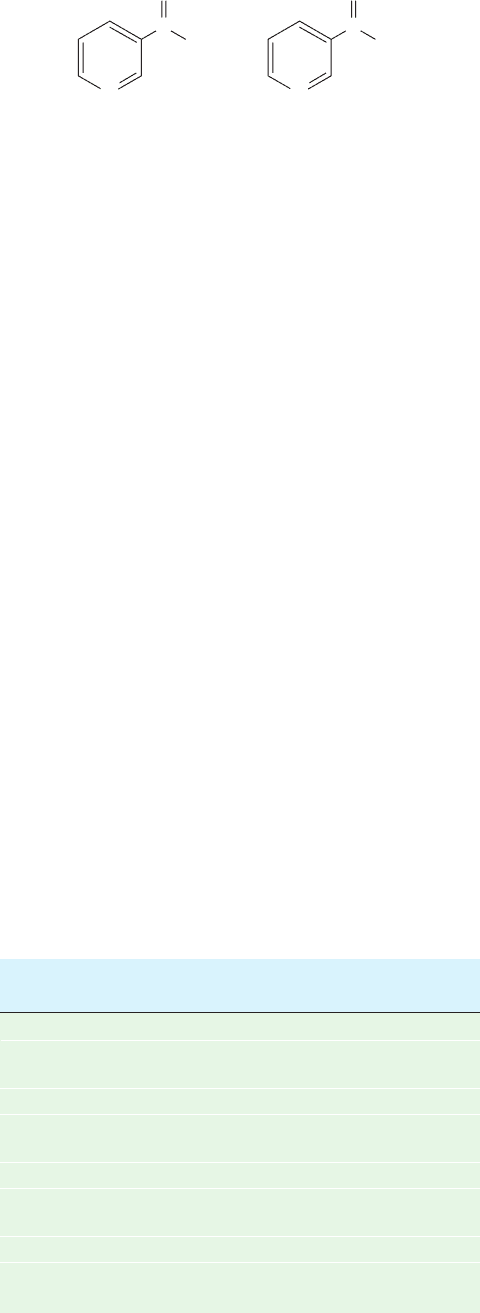
describe the structures of these substances and their reac-
tion mechanisms in the appropriate sections of the textbook.
a. Many Vitamins Are Coenzyme Precursors
Many organisms are unable to synthesize certain por-
tions of essential cofactors and therefore these substances
must be present in the organism’s diet; thus they are vita-
mins. In fact, many coenzymes were discovered as growth
factors for microorganisms or substances that cure nutri-
tional deficiency diseases in humans and animals. For ex-
ample, the NAD
⫹
component nicotinamide (alternatively
known as niacinamide) or its carboxylic acid analog nico-
tinic acid (niacin; Fig. 13-4), relieves the dietary deficiency
disease in humans known as pellagra. Pellagra, which is
characterized by diarrhea, dermatitis, and dementia, was
endemic in the rural southern United States in the early
twentieth century. Most animals, including humans, can
synthesize nicotinamide from the amino acid tryptophan
(Section 28-5A). The corn-rich diet that was prevalent in
the rural South, however, contained little available nico-
tinamide or tryptophan from which to synthesize it. [Corn
actually contains significant quantities of nicotinamide but
in a form that requires treatment with base before it can
be intestinally absorbed. The Mexican Indians, who are
thought to have domesticated the corn plant, customarily
soak corn meal in lime water—dilute Ca(OH)
2
solution—
before using it to make their staple food, tortillas.]
The vitamins in the human diet that are coenzyme pre-
cursors are all water-soluble vitamins (Table 13-2). In con-
trast, the lipid-soluble vitamins, such as vitamins A and D,
are not components of coenzymes, although they are also
required in trace amounts in the diets of many higher ani-
mals. The distant ancestors of humans probably had the
ability to synthesize the various vitamins, as do many mod-
ern plants and microorganisms.Yet, since vitamins are nor-
mally available in the diets of higher animals, which all eat
other organisms, or are synthesized by the bacteria that
normally inhabit their digestive systems, it is believed that
the then superfluous cellular machinery to synthesize them
was lost through evolution.
4 CONTROL OF ENZYMATIC ACTIVITY
An organism must be able to control the catalytic activities
of its component enzymes so that it can coordinate its nu-
merous metabolic processes, respond to changes in its envi-
ronment, and grow and differentiate, all in an orderly man-
ner.There are two ways that this may occur:
1. Control of enzyme availability: The amount of a
given enzyme in a cell depends on both its rate of synthesis
and its rate of degradation. Each of these rates is directly
controlled by the cell. For example, E. coli grown in the ab-
sence of the disaccharide lactose (Fig. 11-13) lack the en-
zymes to metabolize this sugar.Within minutes of their ex-
posure to lactose, however, these bacteria commence
synthesizing the enzymes required to utilize this nutrient
(Section 31-1Aa). Similarly, the various tissues of a higher
organism contain different sets of enzymes, although most
of its cells contain identical genetic information. How cells
achieve this control of enzyme synthesis is a major subject
of Part V of this textbook. The degradation of proteins is
discussed in Section 32-6.
2. Control of enzyme activity: An enzyme’s catalytic ac-
tivity may be directly controlled through conformational or
structural alterations. The rate of an enzymatically cat-
alyzed reaction is directly proportional to the concentra-
tion of its enzyme–substrate complex, which, in turn, varies
with the enzyme and substrate concentrations and with the
enzyme’s substrate-binding affinity (Section 14-2A). The
catalytic activity of an enzyme can therefore be controlled
through the variation of its substrate-binding affinity. Re-
call that Sections 10-1 and 10-4 detail how hemoglobin’s
oxygen affinity is allosterically controlled by the binding of
ligands such as O
2
,CO
2
,H
⫹
, and BPG. These homotropic
and heterotropic effects (ligand binding that, respectively,
alters the binding affinity of the same or different ligands)
result in cooperative (sigmoidal) O
2
-binding curves such as
those of Figs. 10-6 and 10-8. An enzyme’s substrate-binding
affinity may likewise vary with the binding of small mole-
cule effectors, thereby changing the enzyme’s catalytic activ-
ity. In this section we consider the allosteric control of en-
zymatic activity by examining one particular example:
aspartate transcarbamoylase (ATCase) from E. coli. (The
activities of many enzymes are similarly controlled through
474 Chapter 13. Introduction to Enzymes
Table 13-2 Vitamins That Are Coenzyme Precursors
Human
Vitamin Coenzyme Deficiency Disease
Biotin Biocytin a
Cobalamin (B
12
) Cobalamin (B
12
) Pernicious anemia
coenzymes
Folic acid Tetrahydrofolate Megaloblastic anemia
Nicotinamide Nicotinamide Pellagra
coenzymes
Pantothenate Coenzyme A a
Pyridoxine (B
6
) Pyridoxal a
phosphate
Riboflavin (B
2
) Flavin coenzymes a
Thiamine (B
1
) Thiamine Beriberi
pyrophosphate
a
No specific name; deficiency in humans is rare or unobserved.
Figure 13-4 Structures of nicotinamide and nicotinic acid.
These vitamins form the redox-active components of the nicoti-
namide coenzymes NAD
⫹
and NADP
⫹
(compare with Fig. 13-2).
N
Nicotinamide
(niacinamide)
C
O
NH
2
N
Nicotinic acid
(niacin)
C
O
OH
JWCL281_c13_467-481.qxd 2/18/10 11:26 AM Page 474
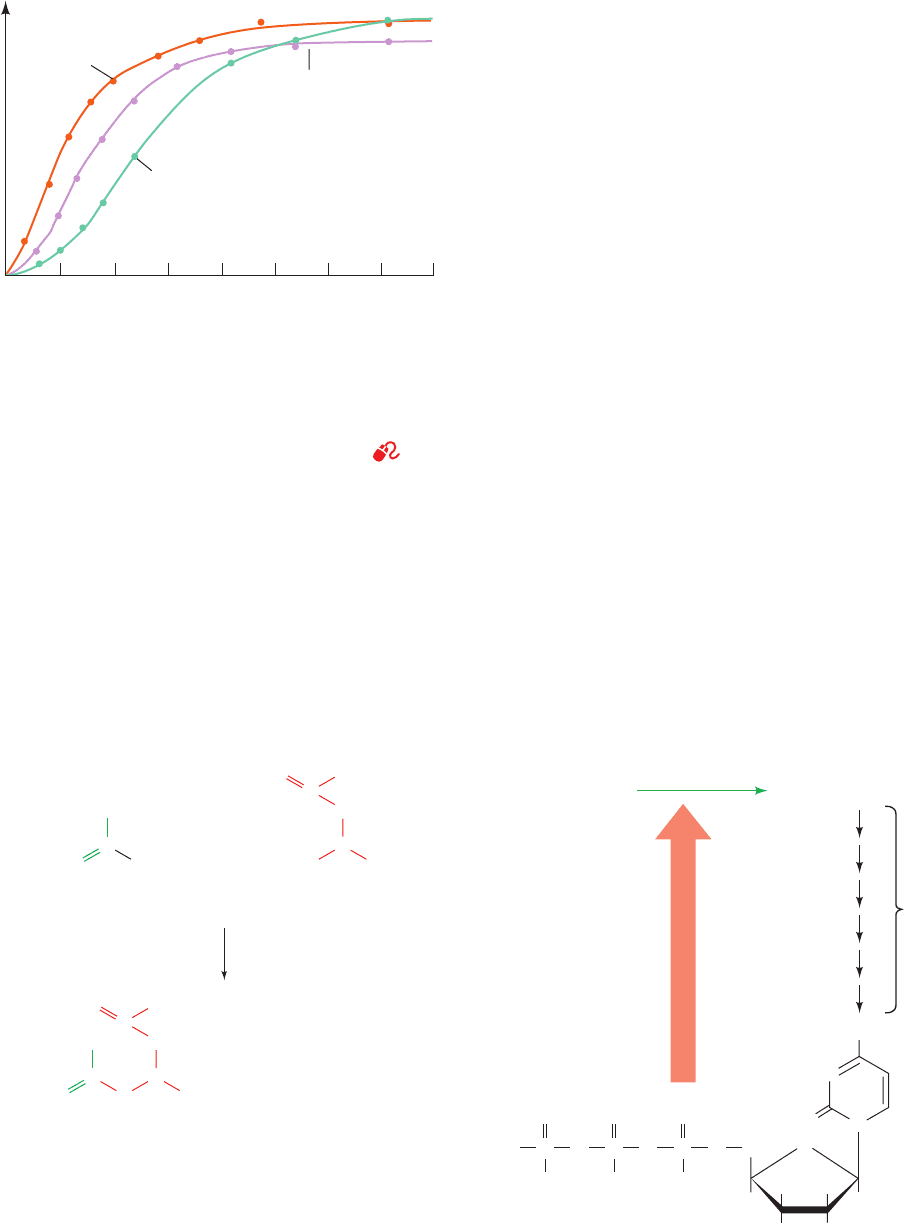
Section 13-4. Control of Enzymatic Activity 475
their reversible covalent modification, usually by the phos-
phorylation of a Ser residue. We study this form of enzy-
matic control in Section 18-3.)
a. The Feedback Inhibition of ATCase Controls
Pyrimidine Biosynthesis
Aspartate transcarbamoylase catalyzes the formation of
N-carbamoylaspartate from carbamoyl phosphate and as-
partate:
Arthur Pardee demonstrated that this reaction is the first
step unique to the biosynthesis of pyrimidines (Section 28-
2A), major components of nucleic acids.
The allosteric behavior of E. coli ATCase was investi-
gated by John Gerhart and Howard Schachman, who
demonstrated that this enzyme exhibits positive ho-
motropic cooperative binding of both its substrates, namely,
aspartate and carbamoyl phosphate. Moreover, ATCase is
H
2
PO
–
4
+
+
N
H
N-Carbamoylaspartate
N
H
2
O
O
COO
–
C
H
2
C
C
C
H
OO
–
Carbamoyl phosphate
OPO
2
3
–
NH
2
O
C
Aspartate
aspartate
transcarbamoylase
N
+
H
3
N
O
COO
–
C
H
2
C
C
H
OO
–
heterotropically inhibited by cytidine triphosphate (CTP),
a pyrimidine nucleotide, and is heterotropically activated
by adenosine triphosphate (ATP), a purine nucleotide.
CTP therefore decreases the enzyme’s catalytic rate,
whereas ATP increases it (Fig. 13-5).
CTP, a product of the pyrimidine biosynthesis pathway
(Fig. 13-6), is a nucleic acid precursor (Section 5-4). Conse-
quently, when rapid nucleic acid biosynthesis has depleted
a cell’s CTP pool, this effector dissociates from ATCase
through mass action, thereby deinhibiting the enzyme and
increasing the rate of CTP synthesis. Conversely, if the rate
of CTP synthesis outstrips its rate of uptake, the resulting
excess CTP inhibits ATCase, which, in turn, reduces the
rate of CTP synthesis. This is an example of feedback inhi-
bition, a common mode of metabolic control in which the
concentration of a biosynthetic pathway product controls
the activity of an enzyme near the beginning of that pathway.
The metabolic significance of the ATP activation of
ATCase is that it tends to coordinate the rates of synthesis of
purine and pyrimidine nucleotides for nucleic acid biosyn-
thesis. For instance, if the ATP and CTP concentrations are
out of balance with ATP in excess, ATCase is activated to
synthesize pyrimidines until balance is achieved. (Note:
The ATP concentration in cells is normally greater than the
CTP concentration because ATP is in greater demand.
Hence the ATP concentration required to activate ATCase
is higher than the CTP concentration required to inhibit it
by an equal amount.) Conversely, if CTP is in excess, the re-
sulting CTP inhibition of ATCase permits purine biosyn-
thesis to attain this balance.
Figure 13-5 The rate of the reaction catalyzed by ATCase as a
function of aspartate concentration. The rates were measured in
the absence of allosteric effectors, in the presence of 0.4 mM
CTP (inhibition), and in the presence of 2.0 mM ATP
(activation). [After Kantrowitz, E.R., Pastra-Landis, S.C., and
Lipscomb, W.N., Trends Biochem. Sci. 5, 125 (1980).]
See the
Animated Figures
010
ATP
CTP
No allosteric
effectors
20
[Aspartate] (mM)
Relative reaction rate
30 40
O
HH
H
HO
CH
2
NH
2
N
O
P
OO
O
–
Cytidine triphosphate (CTP)
O
O
P
O
O
–
O
P
–
O
O
–
N
I
N
H
I
B
I
T
I
O
N
I
N
H
I
B
I
T
I
O
N
ATCase
N-Carbamoyl aspartate
Carbamoyl phosphate
Aspartate
+
6 enzymatic
reaction steps
OH
H
Figure 13-6 Schematic representation of the pyrimidine
biosynthesis pathway. CTP, the end product of the pathway,
inhibits ATCase, which catalyzes the pathway’s first step.
JWCL281_c13_467-481.qxd 2/18/10 11:26 AM Page 475
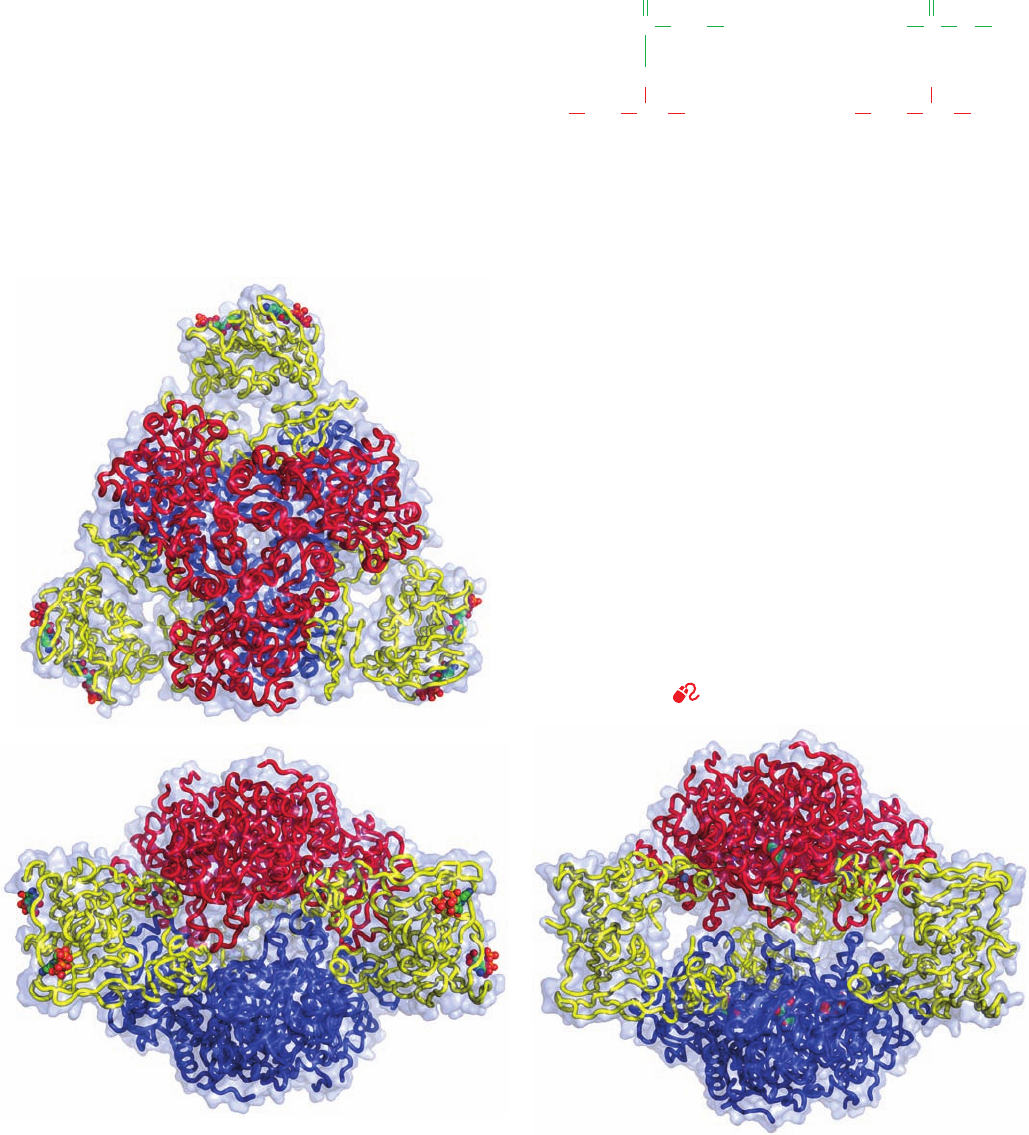
b. Allosteric Changes Alter ATCase’s
Substrate-Binding Sites
E. coli ATCase (309 kD) has the subunit composition
c
6
r
6
, where c and r represent its catalytic and regulatory
subunits (311 and 153 residues). The X-ray structure of
ATCase (Fig.13-7), determined by William Lipscomb,reveals
that the catalytic subunits are arranged as two sets of
trimers (c
3
) in complex with three sets of regulatory dimers
(r
2
) to form a molecule with the rotational symmetry of a
trigonal prism (D
3
symmetry; Section 8-5B). Each regula-
tory dimer joins two catalytic subunits in different c
3
trimers.
Dissociated catalytic trimers retain their catalytic activ-
ity, exhibit a noncooperative (hyperbolic) substrate satura-
tion curve, have a maximum catalytic rate higher than that
of intact enzyme, and are unaffected by the presence of
either ATP or CTP. The isolated regulatory dimers bind
these allosteric effectors but are devoid of enzymatic activity.
Evidently, the regulatory subunits allosterically reduce the
activity of the catalytic subunits in the intact enzyme.
As allosteric theory predicts (Section 10-4), the activa-
tor ATP preferentially binds to ATCase’s active (R or high
substrate affinity) state, whereas the inhibitor CTP prefer-
entially binds to the enzyme’s inactive (T or low substrate
affinity) state. Similarly, the unreactive bisubstrate analog
N-(phosphonacetyl)-
L-aspartate (PALA)
476 Chapter 13. Introduction to Enzymes
N-(Phosphonacetyl)-
L-aspartate (PALA)
NH
CH
O
C
CH
2
COO
–
CH
2
–
OOC
PO
2–
3
Carbamoyl phosphate
+
Aspartate
NH
3
+
CH
O
CH
2
N
CH
2
COO
–
O
–
OOC
PO
2–
3
(a)
Figure 13-7 X-ray structure of ATCase from E. coli. The
T-state enzyme in complex with CTP is viewed (a) along the
protein’s molecular 3-fold axis of symmetry and (b) along a
molecular 2-fold axis of symmetry perpendicular to the view in
Part a. The polypeptide chains are drawn in worm form
embedded in their transparent molecular surface. The regulatory
dimers (yellow) join the upper catalytic trimer (red) to the lower
catalytic trimer (blue). CTP is drawn in space-filling form colored
according to atom type (C green, O red, N blue, and P orange).
(c) The R-state enzyme in complex with PALA viewed as in Part
b. PALA is drawn in space-filling form. Note how the rotation of
the regulatory dimers in the T S R transition causes the catalytic
trimers to move apart along the 3-fold axis. [Based on X-ray
structures by William Lipscomb, Harvard University. PDBids
5AT1 and 8ATC.]
See Kinemage Exercise 11-1
binds tightly to R-state but not to T-state ATCase (the use
of unreactive substrate analogs is common in the study of
enzyme mechanisms because they form stable complexes
(a)
(b)
(c)
JWCL281_c13_467-481.qxd 2/18/10 11:27 AM Page 476
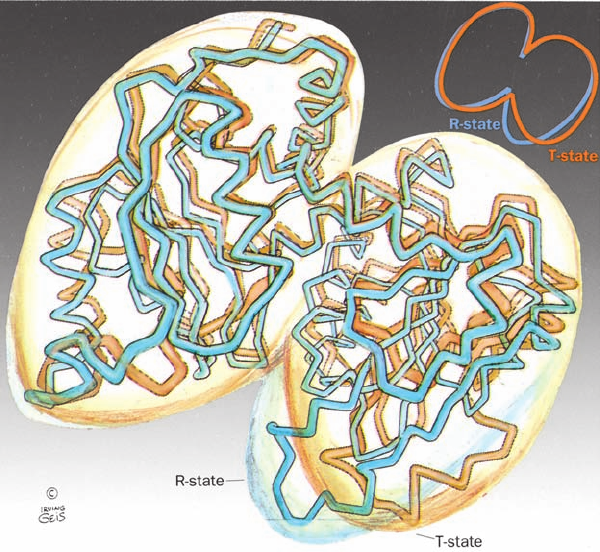
that are amenable to structural study rather than rapidly
reacting to form products as do true substrates).
The X-ray structures of the T-state ATCase–CTP com-
plex and the R-state ATCase–PALA complex reveal that
the T S R transition maintains the protein’s D
3
symmetry.
The comparison of these two structures (Fig. 13-7) indi-
cates that in the T S R transition, the enzyme’s catalytic
trimers separate along the molecular 3-fold axis by ⬃11 Å
and reorient about this axis relative to each other by 12°
such that these trimers assume a more nearly eclipsed con-
figuration than is seen in Fig. 13-7a. In addition, the regula-
tory dimers rotate clockwise by 15° about their 2-fold axes
and separate by ⬃4 Å along the 3-fold axis. Such large qua-
ternary shifts are reminiscent of those in hemoglobin (Sec-
tion 10-2B).
ATCase’s substrates, carbamoyl phosphate and aspar-
tate, each bind to a separate domain of the catalytic subunit
(Fig. 13-8). The binding of PALA to the enzyme, which pre-
sumably mimics the binding of both substrates, induces ac-
tive site closure in a manner that would bring them together
so as to promote their reaction. The resulting atomic shifts,
up to 8 Å for some residues (Fig. 13-8), trigger ATCase’s
T S R quaternary shift. Indeed, ATCases’s tertiary and
quaternary shifts are so tightly coupled through extensive
intersubunit contacts (see below) that they cannot occur in-
dependently (Fig. 13-9). The binding of substrate to one cat-
alytic subunit therefore increases the substrate-binding
affinity and catalytic activity of the other catalytic subunits
and hence accounts for the enzyme’s positively coopera-
tive substrate binding, much as occurs in hemoglobin (Sec-
tion 10-2C). Thus, low levels of PALA actually activate
ATCase by promoting its T S R transition: ATCase has
such high affinity for this unreactive bisubstrate analog that
the binding of one molecule of PALA converts all six of its
catalytic subunits to the R state. Evidently, ATCase closely
follows the symmetry model of allosterism (Section 10-4B).
c. The Structural Basis of Allosterism in ATCase
What are the interactions that stabilize the T and R
states of ATCase and why must their interconversion be
concerted? The region of the protein that undergoes the
most profound conformational rearrangement with the
T S R transition is a flexible loop composed of residues
230 to 250 in the catalytic (c) subunit, the so-called 240s
loop [the symmetry-related red and blue loops that lie side
by side in the T state (center of Fig. 13-7b) but are vertically
apposed in the R state (center of Fig. 13-7c)]. In the T state,
each 240s loop forms two intersubunit hydrogen bonds
Section 13-4. Control of Enzymatic Activity 477
Figure 13-8 Comparison of the polypeptide backbones of the
ATCase catalytic subunit in the T state (orange) and the R state
(blue). The subunit consists of two domains, with the one on the
left containing the carbamoyl phosphate binding site and that on
the right forming the aspartic acid binding site. The T S R
transition brings the two domains together such that their two
bound substrates can react to form product. [Illustration, Irving
Geis. Image from the Irving Geis Collection, Howard Hughes
Medical Institute. Reprinted with permission.] X-ray structures
by William Lipscomb, Harvard University.]
JWCL281_c13_467-481.qxd 8/10/10 9:59 AM Page 477
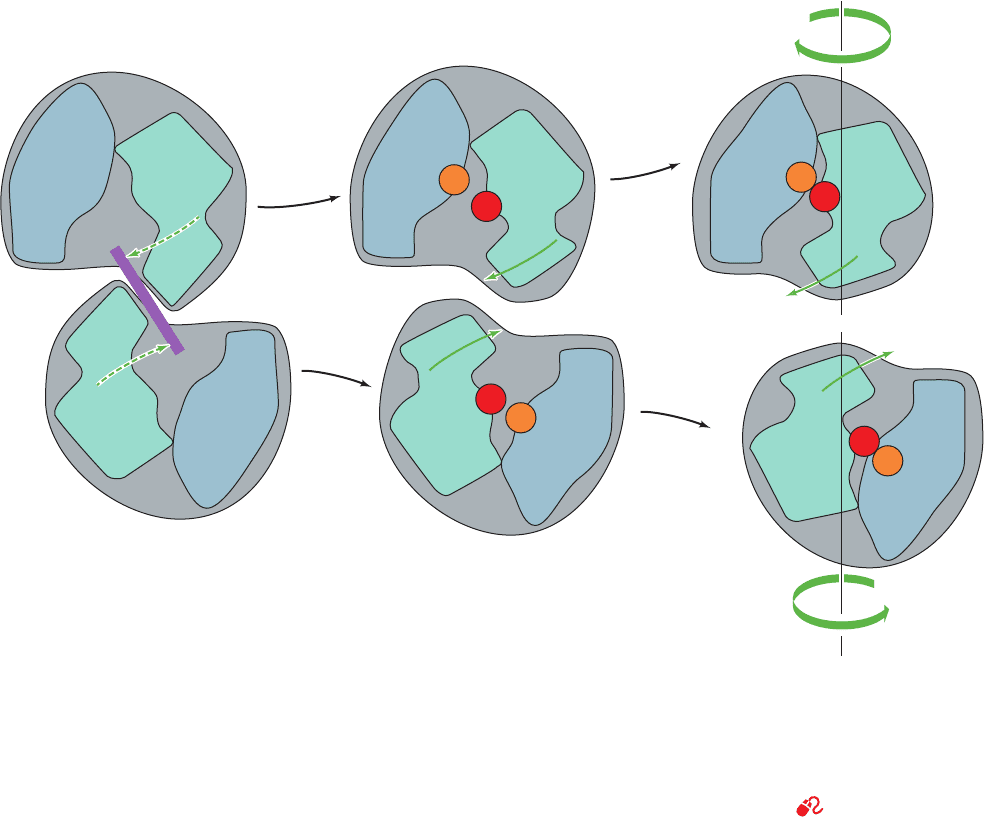
with the vertically opposite c subunit (Fig. 13-7b), together
with an intrasubunit hydrogen bond. Domain closure as a
consequence of substrate binding (Figs. 13-8 and 13-9) rup-
tures these hydrogen bonds and replaces them, in the
R state, with new intrachain hydrogen bonds. The conse-
quent reorientation of the 240s loop is thought to be
largely responsible for the quaternary shift to the R state
(see below). Since the Glu 239 carboxyl group is the accep-
tor in all of the above T-state interchain and R-state intra-
chain hydrogen bonds, this hypothesis is corroborated by
the observation that the mutation of Glu 239 to Gln con-
verts ATCase to an enzyme that is devoid of both ho-
motropic and heterotropic effects and that has a quaternary
structure midway between those of the R and T states.
What is the structural basis for heterotropic effects in
ATCase? Both the inhibitor CTP and the activator ATP
bind to the same site on the outer edge of the regulatory (r)
subunit, about 60 Å away from the nearest catalytic site.
CTP binds preferentially to the T state,increasing its stabil-
ity, while ATP binds preferentially to the R state, increasing
its stability. The binding of these effectors to their less fa-
vored states also has structural consequences. When CTP
binds to R-state ATCase, it reorients several residues at the
nucleotide binding site, which induces a contraction in the
length of the regulatory dimer (r
2
).This distortion, through
the interactions of residues at the r–c interface, causes the
catalytic trimers (c
3
) to come together by 0.5 Å (become
more T-like, that is, less active, which presumably destabi-
lizes the R state).This, in turn, reorients key residues in the
enzyme’s active sites, thereby decreasing the enzyme’s cat-
alytic activity. ATP has essentially opposite effects when
binding to the T-state enzyme: It causes the catalytic
trimers to move apart by 0.4 Å (become more R-like, that
is, more active, which presumably destabilizes the T state),
thereby reorienting key residues in the enzyme’s active
sites so as to increase the enzyme’s catalytic activity. The
binding of CTP to T-state ATCase does not further com-
press the catalytic trimers but, nevertheless, perturbs active
478 Chapter 13. Introduction to Enzymes
Figure 13-9 Schematic diagram indicating the tertiary and
quaternary conformational changes in two vertically interacting
catalytic ATCase subunits. (a) In the absence of bound substrate
the protein is held in the T state because the motions that bring
together the two domains of each subunit (dashed arrows) are
prevented by steric interference (purple bar) between the
contacting aspartic acid binding domains. (b) The binding of
carbamoyl phosphate (CP) followed by aspartic acid (Asp) to
T state R state(a) (b) (c)
Catalytic monomer
Carbamoyl
phosphate-
binding
domain
Aspartate-
binding
domain
Catalytic monomer
CP
CP
CP
CP
Asp
Asp
Asp
Asp
their respective binding sites causes the subunits to move apart
and rotate with respect to each other so as to permit the T S R
transition. (c) In the R state, the two domains of each subunit
come together so as to promote the reaction of their bound
substrates to form products. [Illustration, Irving Geis. Image
from the Irving Geis Collection, Howard Hughes Medical
Institute. Reprinted with permission.]
See Kinemage Exercises
11-1 and 11-2
JWCL281_c13_467-481.qxd 8/10/10 9:59 AM Page 478

site residues in a way that further stabilizes the T state.Al-
though the X-ray structure of ATP complexed to R-state
ATCase has not yet been reported, it is expected that ATP
binding perturbs the R state in a manner analogous but op-
posite to the binding of CTP to T-state ATCase.
d. Allosteric Transitions in Other Enzymes Resemble
Those of Hemoglobin and ATCase
Allosteric enzymes are widely distributed in nature and
tend to occupy key regulatory positions in metabolic path-
ways. Three such enzymes, in addition to hemoglobin and
ATCase, have had their X-ray structures determined in
both their R and T states: phosphofructokinase (Sections
17-2C and 17-4F), fructose-1,6-bisphosphatase (Section 23-
1Ah), and glycogen phosphorylase (Section 18-1A). In all
five proteins, quaternary changes, through which binding
and catalytic effects are communicated among active sites,
are concerted and preserve the symmetry of the protein.
This is because each of these proteins has two sets of alter-
native contacts, which are stabilized largely by hydrogen
bonds that mostly involve side chains of opposite charge. In
all five proteins, the quaternary shifts are primarily rota-
tions of subunits relative to one another with only small
translations. Secondary structures are largely preserved in
T S R transitions, which is probably important for me-
chanically transmitting heterotropic effects over the tens of
Ångstroms necessary in these proteins.The ubiquity of these
structural features among allosteric proteins of known
structures suggests that the control mechanisms of other
allosteric enzymes, by and large, follow this model.
5 A PRIMER OF ENZYME
NOMENCLATURE
Enzymes, as we have seen throughout the text so far, are
commonly named by appending the suffix -ase to the name
of the enzyme’s substrate or to a phrase describing the en-
zyme’s catalytic action. Thus urease catalyzes the hydroly-
sis of urea and alcohol dehydrogenase catalyzes the oxida-
tion of alcohols to their corresponding aldehydes. Since
there were at first no systematic rules for naming enzymes,
this practice occasionally resulted in two different names
being used for the same enzyme or, conversely, in the same
name being used for two different enzymes. Moreover,
many enzymes, such as catalase, which mediates the dismu-
tation of H
2
O
2
to H
2
O and O
2
, were given names that pro-
vide no clue as to their function; even such atrocities as
“old yellow enzyme” had crept into use. In an effort to
eliminate this confusion and to provide rules for rationally
naming the rapidly growing number of newly discovered
enzymes, a scheme for the systematic functional classifica-
tion and nomenclature of enzymes was adopted by the In-
ternational Union of Biochemistry and Molecular Biology
(IUBMB).
Enzymes are classified and named according to the
nature of the chemical reactions they catalyze. There are
six major classes of reactions that enzymes catalyze (Table
13-3), as well as subclasses and sub-subclasses within these
classes. Each enzyme is assigned two names and a four-
number classification. Its accepted or recommended name
is convenient for everyday use and is often an enzyme’s
previously used name. Its systematic name is used when
ambiguity must be minimized; it is the name of its sub-
strate(s) followed by a word ending in -ase specifying the
type of reaction the enzyme catalyzes according to its ma-
jor group classification. For example, the Enzyme Nomen-
clature Database (available from http://www.brenda-
enzymes.info/ and from http://www.chem.qmul.ac.uk/iubmb/
enzyme/) indicates that the enzyme whose alternative
name is lysozyme (Section 11-3Ba) has the systematic
name peptidoglycan N-acetylmuramoylhydrolase and the
Classification Number EC 3.2.1.17. Here “EC” stands for
Enzyme Commission, the first number (3) indicates the en-
zyme’s major class (hydrolases; Table 13-3), the second
number (2) denotes its subclass (glycosylases), the third
number (1) designates its sub-subclass (enzymes hydrolyz-
ing O- and S-glycosyl compounds), and the fourth number
(17) is the enzyme’s arbitrarily assigned serial number in its
sub-subclass.As another example, the enzyme with the rec-
ommended name alcohol dehydrogenase has the system-
atic name alcohol:NAD
⫹
oxidoreductase and the classifi-
cation number EC 1.1.1.1. In this text, as in general
biochemical terminology, we shall most often use the
recomended names of enzymes but when ambiguity must be
minimized, we shall refer to an enzyme’s systematic name.
Section 13-5. A Primer of Enzyme Nomenclature 479
Table 13-3 Enzyme Classification According to
Reaction Type
Classification Type of Reaction Catalyzed
1. Oxidoreductases Oxidation–reduction reactions
2. Transferases Transfer of functional groups
3. Hydrolases Hydrolysis reactions
4. Lyases Group elimination to
form double bonds
5. Isomerases Isomerization
6. Ligases Bond formation coupled
with ATP hydrolysis
JWCL281_c13_467-481.qxd 2/18/10 11:27 AM Page 479

480 Chapter 13. Introduction to Enzymes
2 Substrate Specificity Enzymes specifically bind their
substrates through geometrically and physically complemen-
tary interactions. This permits enzymes to be absolutely stere-
ospecific, both in binding substrates and in catalyzing reac-
tions. Enzymes vary in the more stringent requirement of
geometric specificity. Some are highly specific for the identity
of their substrates, whereas others can bind a wide range of
substrates and catalyze a variety of related types of reactions.
3 Coenzymes Enzymatic reactions involving oxidation–
reduction reactions and many types of group-transfer processes
are mediated by coenzymes. Many vitamins are coenzyme
precursors.
4 Control of Enzyme Activity Enzymatic activity may be
regulated by the allosteric alteration of substrate-binding affin-
ity. For example, the rate of the reaction catalyzed by E. coli
ATCase is subject to positive homotropic control by substrates,
heterotropic inhibition by CTP, and heterotropic activation by
ATP. ATCase has the subunit composition c
6
r
6
. Its isolated cat-
alytic trimers are catalytically active but not subject to allosteric
control. The regulatory dimers bind ATP and CTP. Substrate
binding induces a tertiary conformational shift in the catalytic
subunits, which increases the subunit’s substrate-binding affin-
ity and catalytic efficiency.This tertiary shift is strongly coupled
to ATCase’s large quaternary T S R conformational shift,
thereby accounting for the enzyme’s allosteric properties. Other
allosteric enzymes appear to operate in a similar manner.
5 A Primer of Enzyme Nomenclature Enzymes are clas-
sified according to their recommended name, their systematic
name, and their EC classification number, which is indicative
of the type of reaction catalyzed by the enzyme.
CHAPTER SUMMARY
History
Friedmann, H.C. (Ed.), Enzymes, Hutchinson Ross (1981). [A
compendium of classic enzymological papers published be-
tween 1761 and 1974; with commentary.]
Fruton, J.S., Molecules and Life, pp. 22–86, Wiley (1972).
Schlenk, F., Early research on fermentation—a story of missed op-
portunities, Trends Biochem. Sci. 10, 252–254 (1985).
Substrate Specificity
Creighton, D.J. and Murthy, N.S.R.K., Stereochemistry of enzyme-
catalyzed reactions at carbon, in Sigman, D.S. and Boyer, P.D.
(Eds.), The Enzymes (3rd ed.),Vol. 19, pp. 323–421, Academic
Press (1990). [Section II discusses the stereochemistry of reac-
tions catalyzed by nicotinamide-dependent dehydrogenases.]
Fersht, A., Structure and Mechanism in Protein Science, Freeman
(1999).
Lamzin, V.S., Sauter, Z., and Wilson, K.S., How nature deals with
stereoisomers, Curr. Opin. Struct. Biol. 5, 830–836 (1995).
Mesecar, A.D. and Koshland, D.E., Jr., A new model for protein
stereospecificity, Nature 403, 614–615 (2000).
Ringe, D., What makes a binding site a binding site? Curr. Opin.
Struct. Biol. 5, 825–829 (1995).
Weinhold, E.G., Glasfeld, A., Ellington, A.D., and Benner, S.A.,
Structural determinants of stereospecificity in yeast alcohol
dehydrogenase, Proc. Natl. Acad. Sci. 88, 8420–8424 (1991).
Control of Enzyme Activity
Allewell, N.M., Escherichia coli aspartate transcarbamoylase:
Structure, energetics, and catalytic and regulatory mechanisms,
Annu. Rev. Biophys. Biophys. Chem. 18, 71–92 (1989).
Evans, P.R., Structural aspects of allostery, Curr. Opin. Struct. Biol. 1,
773–779 (1991).
Gouaux, J.E., Stevens, R.C., Ke, H., and Lipscomb, W.N., Crystal
structure of the Glu-289 S Gln mutant of aspartate
carbamoyl-transferase at 3.1-Å resolution: An intermediate
quaternary structure, Proc. Natl. Acad. Sci. 86, 8212–8216
(1989).
Jin, L., Stec, B., Lipscomb, W.N., and Kantrowitz, E.R., Insights
into the mechanisms of catalysis and heterotropic regulation of
Escherichia coli aspartate transcarbamoylase based upon a
structure of the enzyme complexed with the bisubstrate
analogue N-phosphonacetyl-
L-aspartate at 2.1 Å, Proteins 37,
729–742 (1999).
Kantrowitz, E.R. and Lipscomb, W.N., Escherichia coli aspartate
transcarbamylase: The molecular basis for a concerted al-
losteric transition, Trends Biochem. Sci. 15, 53–59 (1990).
Koshland, D.E., Jr., The key–lock theory and the induced fit the-
ory, Angew. Chem. Int. Ed. Engl. 33, 2375–2378 (1994).
Macol, C.P., Tsuruta, H., Stec, B., and Kantrowitz, E.R., Direct
structural evidence for a concerted allosteric transition in Es-
cherichia coli aspartate transcarbamoylase, Nature Struct. Biol. 8,
423–426 (2001).
Schachman, H.K., Can a simple model account for the allosteric
transition of aspartate transcarbamoylase? J. Biol. Chem. 263,
18583–18586 (1988).
Stevens, R.C. and Lipscomb, W.N., A molecular mechanism for
pyrimidine and purine nucleotide control of aspartate trans-
carbamoylase, Proc. Natl. Acad. Sci. 89, 5281–5285 (1992).
Zhang,Y. and Kantrowitz, E.R., Probing the regulatory site of Es-
cherichia coli aspartate transcarbamoylase by site specific mu-
tagenesis, Biochemistry 31, 792–798 (1992).
Enzyme Nomenclature
Tipton, K.F., The naming of parts, Trends Biochem. Sci. 18,
113–115 (1993). [A discussion of the advantages of a consistent
naming scheme for enzymes and the difficulties of formulating
one.]
REFERENCES
JWCL281_c13_467-481.qxd 2/18/10 11:27 AM Page 480
